Easy Sourdough Starter
This Easy Sourdough Starter recipe creates gorgeously fluffy homemade products such as Sourdough Baguettes. Included are simple step by step instructions on how to start, feed and Maintain Sourdough Starter that is perfect for beginners.
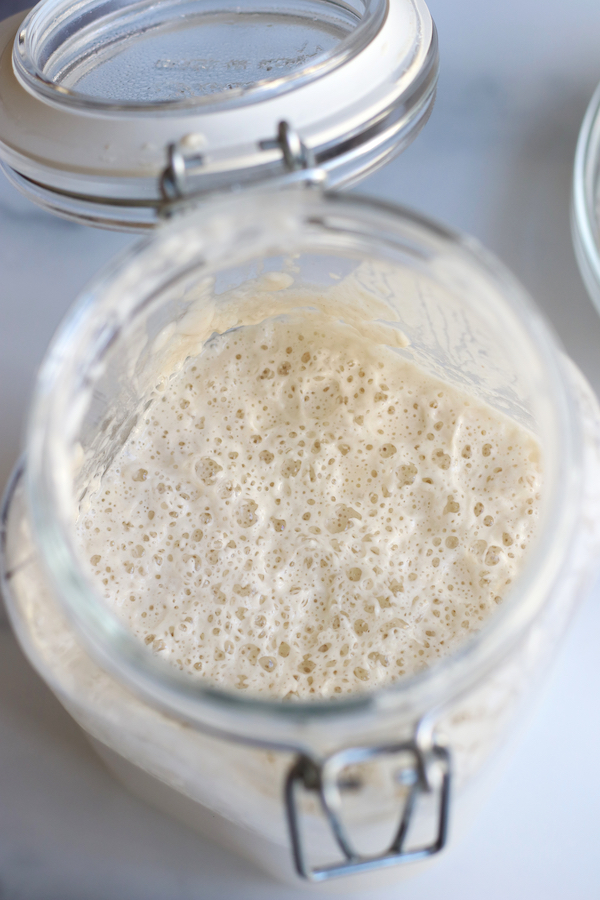
This post may contain affiliate links which I earn a small portion in sales if a purchase is made. Rest assured though, it is never at any additional cost to you.
What is Sourdough Starter
Very simply, sourdough starter is a fermented mixture of two ingredients, water and flour. Wild yeast found in flour flourishes when added to water and is allowed to rest in between feedings. This approach is the old fashioned way of making bread that has been done for centuries. It does require more time than active-dry or instant yeast but produces exceptional taste and textured baked goods.
Tools Needed
In addittion to the flour and water a few tools are needed to make your own from scratch Sourdough Starter.
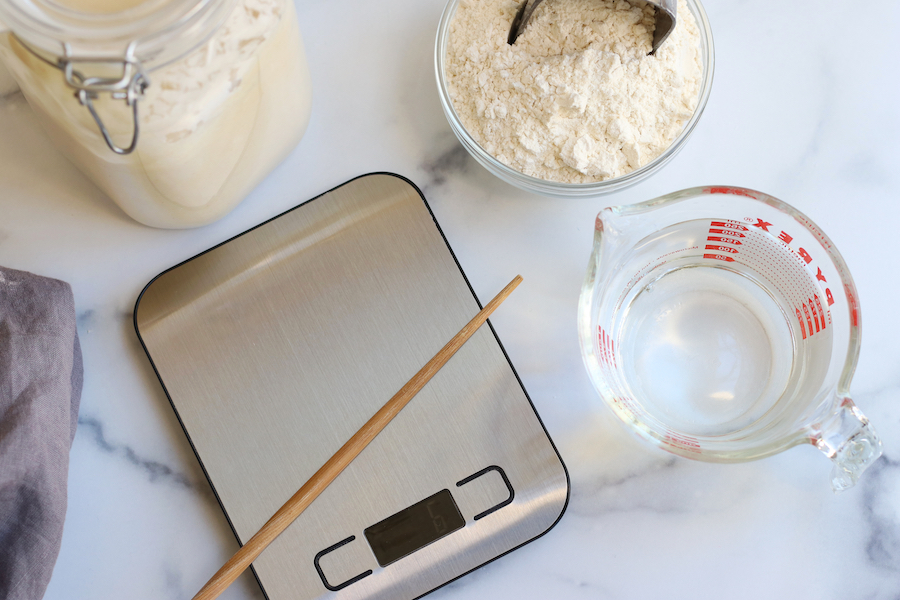
- Kitchen Scale- It is highly encouraged to use a kitchen scale to weigh the flour and water in equals parts to achieve the best results. This is the scale shown in the picture above. However, my next kitchen scale will be a little larger to accommodate the large bowl needed to make sourdough bread.
- Chopsticks– This makes stirring the starter in a glass jar much easier.
- Glass Measuring Cup– Makes for easy pouring of water.
- Scoop or Spoon– Helps with the addittion of flour.
- Medium Sized Glass Bowl– The first few days of a starters life is easier done in a medium size glass bowl.
- Plastic Wrap or Reusable Food Wraps– For the first few days of the starters life.
- Glass Jar (see below)
Sourdough Starter Container
The type of glass jar needed will depend on which type of flour you use to make your starter and how rapidly your starter ferments. This is the jar seen in the photo below and it works beautifully when using white all-purpose flour. Please see section directly below (White Flour vs Wheat Flour) for more explanation.

Best Flour for Sourdough Success
For the best sourdough starter, you need flour you can trust. Buying directly from King Arthur Flour means guaranteed freshness, expert-tested quality, and no risk of warehouse mishandling. Plus, you’ll find exclusive products, better stock availability, and support an employee-owned company dedicated to bakers. Skip the third-party markups and get the best right from the source. You and your sourdough deserve it! (affiliate)
White Flour vs Wheat Flour
The type of flour used will have a great influence on how your Stater ferments and the final product that you make with it. However, it is most important to not choose bleached flour as this will impede the fermentation.
All-Purpose White Flour
I adore sourdough bread that bites me back when I eat it. In other words, extra sour with a tang. However, my husband HATES that kind of bread. That is why I use all-purpose white flour for my Starter.
This type of flour yields breads that are very much like a crusty Italian loaf that he and I both go crazy for. Additionally, I use the Starter from this type of flour for making baguettes that then make incredible Homemade Breadcrumbs and croutons. The final products are never overly sour.
Wheat or Rye Flour
Wheat and rye flour has more naturally occurring wild yeast. Because of this, the starter made from these types of flours will ferment faster and with more intensity. It is very important to keep a closer eye on Starters made from these flours and to use a glass jar that has a lid that is looser or can be left slightly open. The reason for this, a tight fitting lid could be a recipe for an exploding jar.
In conclusion, wheat and rye flours will make much stronger sourdough products and all-purpose white flours (unbleached) will yield more mild final products.
How To Make
To make Sourdough Starter that is ready to bake with will take approximately 7 days, give or take a day or two. Here are the instructions for each day.
Day 1
In a medium sized glass bowl mix together 50 grams of water and 50 grams of flour. Stir well and cover. Let sit at room temperature.
Pro Tip#1– To accurately weigh the flour and water start by making sure the scale is weighing in grams vs ounces. Place the bowl on the scale and turn on. The scale should read zero with the the bowl on top. Add enough flour to equal 50 grams. Calibrate the scale back to zero again and repeat with water.
Pro Tip#2– In the making and feeding of this starter there will always be equal parts of flour and water added to it.
Day 2
To yesterday’s mixture add 50 grams of flour and 50 grams of water. Stir well and cover. Let sit at room temperature.
Day 3
Throw away half of the Starter. To the remaining Starter add 100 grams of flour and 100 grams of water. Stir well and cover. Let sit at room temperature.
Pro Tip#3– The discarded Starter from day 3- day 6 is not fully developed enough to have any uses. Simply throw it away.
Day 4
Throw away half of the starter. Add 150 grams of flour and 150 grams of water to the bowl and stir well. Cover and let sit at room temperature.
Pro Tip#4– Day 4 is the day that you will notice the mixture starting to take on the personality of a Sourdough Starter. There should be small bubbles and a slight sour smell will start to take shape.
Day 5
Similar to the previous days, throw away half of the Starter and add 150 grams of flour and 150 grams of water. Stir well, cover and let sit at room temperature.
Pro Tip#5– The Starter should begin to look very similar to picture A below. If not do not worry, it will very soon. Also, feel free to transfer to the glass jar once the new flour and water its mixed in on day 5.
Day 6
Throw away half of the starter and add 200 grams of flour and 200 grams of water. Stir well, cover and let sit at room temperature.
Pro Tip#6– By day 6 the Starter should look similar to photo A below and very possibly look like photo B.
Day 7
On day 7 the Starter should at the least look like photo B if not like photo C. If it has a similar appearance to photo C, it is ready to use. If it looks like photo B, let it sit at room temperature for one additional day.
Feeding and Reviving Sourdough Starter
Above all, if your Starter looks like photo C it is ready to be used for making all kinds of sourdough products. If it looks like photo B, you can still use it for baking. However, it will slow down the rising of bread dough. When it looks like photo A, it is time to feed the Starter.

To feed the Sourdough Starter, discard half of it and add 150 grams of flour and 150 grams of water to the remaining Starter. Stir well and let sit at room temperature overnight. If on the second day the Starter has the appearance of photo B, let it sit at room temperature for one additional day before using it in recipes.
Pro Tip#7– If storing the Starter at room temperature it will need to be fed every 2-3 days. If storing in the refrigerator, it can be kept safely for up to 10 days before feeding. Please note that if storing in the refrigerator 2 feedings will most likely be needed before the Starter will look like photo C.
Starter Smell and How to Know if it has Gone Bad
A healthy Sourdough Starter is going to smell sour. Therefore, it is not the best way to judge whether it has gone bad. However, the best way to know is by its appearance. If there are any visible signs of mold or red/orange spots it is time to throw the Starter out and begin again. Take heart though, Sourdough Starters are full of good bacteria. Because of this, chances of it going bad are much lower.
Maintaining Sourdough Starter
For anyone new to sourdough baking, it is incredibly normal to have many questions and concerns about maintaining your sourdough starter. How To Maintain Sourdough Starter has a complete breakdown of the feeding schedule, common concerns and questions so that you can enjoy your sourdough starter for decades to come.
If you enjoyed this Sourdough Starter please let me know by leaving a comment and review below. Doing so helps to encourage others to make the recipe also. Thank you!
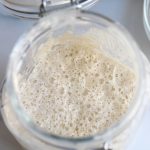
Easy Sourdough Starter
Ingredients
- 700 grams white all-purpose flour *see Note #1 below
- 700 grams filtered water
Instructions
Day 1
- In a medium sized glass bowl mix together 50 grams of water and 50 grams of flour. Stir well and cover. Let sit at room temperature.See Note #2 and Note #3 below.
Day 2
- To yesterday’s mixture add 50 grams of flour and 50 grams of water. Stir well and cover. Let sit at room temperature.
Day 3
- Throw away half of the Starter. To the remaining Starter add 100 grams of flour and 100 grams of water. Stir well and cover. Let sit at room temperature.See Note #3 below.
Day 4
- Throw away half of the starter. Add 150 grams of flour and 150 grams of water to the bowl and stir well. Cover and let sit at room temperature. See Note #4 below.
Day 5
- Similar to the previous days, throw away half of the Starter and add 150 grams of flour and 150 grams of water. Stir well, cover and let sit at room temperature. See Note #5 below.
Day 6
- Throw away half of the starter and add 200 grams of flour and 200 grams of water. Stir well, cover and let sit at room temperature. See Note #6 below.
Day 7
- On day 7 the Starter should at the least look like photo B above if not like photo C. If it has a similar appearance to photo C, it is ready to use. If it looks like photo B, let it sit at room temperature for one additional day.

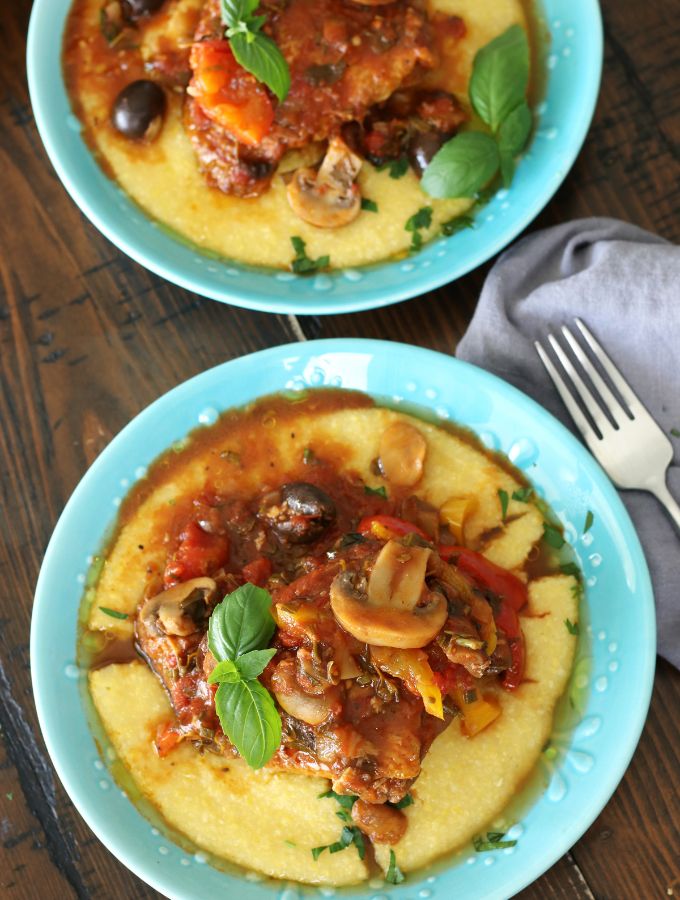


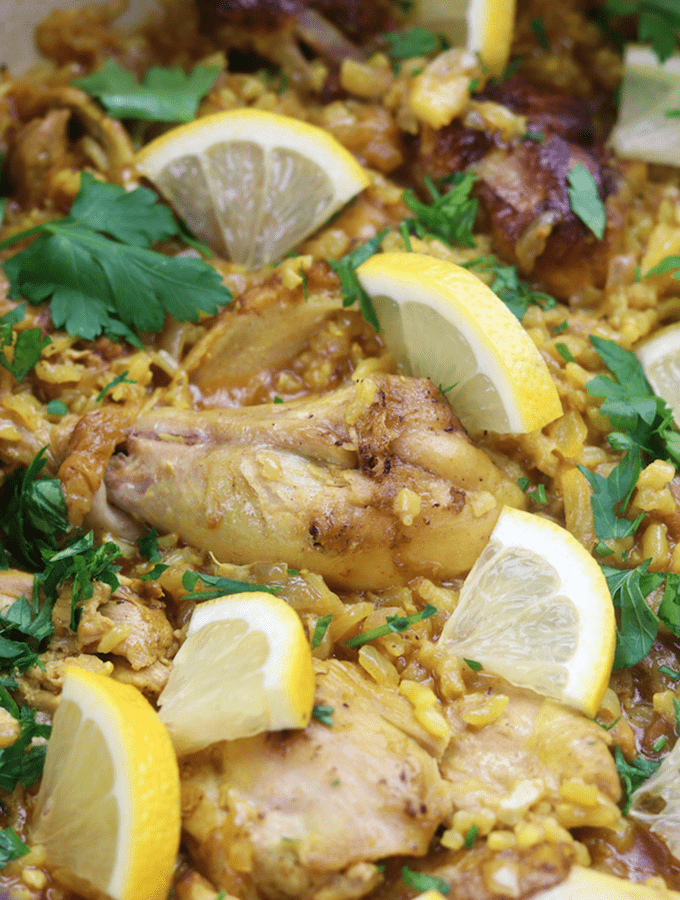
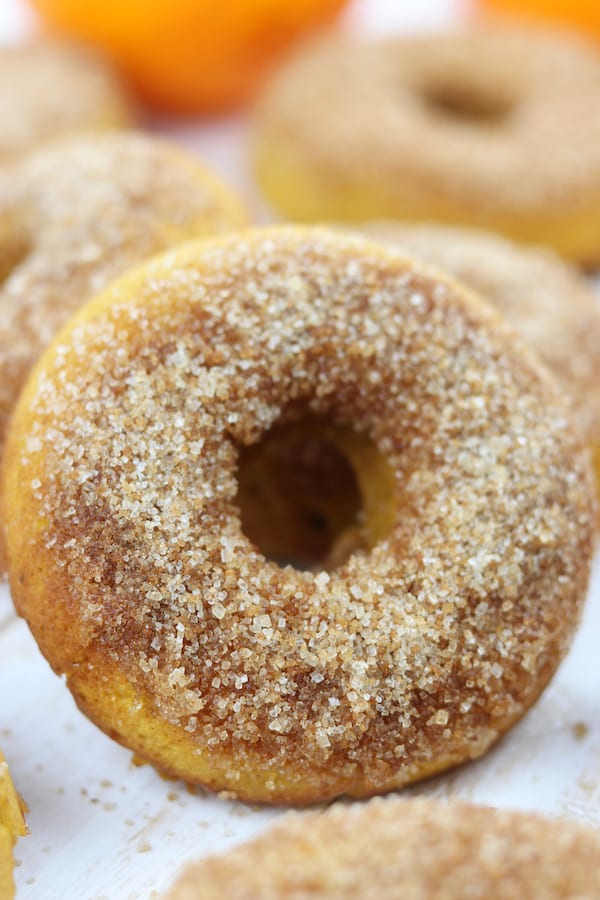

Hi again, Heather. I’m on day 5 and while bubbly, my starter seems really watery. Normal? Doesn’t look like hooch. Thanks.
Hi! Can I start using the discard at day 9?
Hi Dallie. As long as your starter is active and bubbly at this point, you’re good to go ahead and start using it for recipes. Also, this post about maintaining your starter may be helpful. https://www.thefedupfoodie.com/how-to-maintain-sourdough-starter/
Please keep me updated, I would love to hear how it goes.
How do you know what 1/2 is? Do you weigh to determine how much to discard?
Hi Toni. Thank you for asking. You don’t need to weigh it as it’s more of an eyeball method. I simply discard about half based on the volume in the jar, so no need to get too precise. The important part is maintaining the ratio when feeding your starter to keep it healthy and active. Hope this helps!
I did 50 grams water and 50 grams wheat flour….its a blob of oatmeal. Is it supposed to do that?
Hi Pam. It’s perfectly fine to use wheat flour rather than all purpose flour in your starter! However, wheat flour tends to absorb more water, which is why it may look a bit thicker, like oatmeal. You can simply add a few grams more of water to adjust the consistency and your starter should develop beautifully.
Hi there Heather. This is my first time doing this and day 1 for my starter. Do I cover the starter with a cheesecloth or tea towel or with a sealed lid?
Hi Maureen. For the best results, I suggest covering your starter loosely with plastic wrap, like I did, or using a breathable cover such as a tea towel. This allows some airflow while keeping it protected. Just avoid a sealed lid, as your starter needs a bit of oxygen to thrive. Welcome to the sourdough baking journey!
Hello Maureen,
I’m new to sourdough and was wondering if you could also include if this needs to be proofed after kneading and baking instructions?
I appreciate all your help!
Shayla
Hi Shayla, welcome to the world of sourdough baking! Yes, when making sourdough bread, proofing is an important step after kneading. I’d recommend following the specific instructions for the bread recipe you’re using, as proofing times can vary. If you’re just getting started, this Soft Sourdough Bread recipe might be a great place to begin. Feel free to reach out anytime with more questions. Happy baking! https://www.thefedupfoodie.com/soft-sourdough-bread/
Hi there! I am on day 7 and my starter is bubbly, but it looks more like photo B. I know the recipe says to leave it out for one more day, but do I feed it at all today?
Hi Aubrey! It’s totally normal for the starter to take a day or two longer, so no worries there. Go ahead and feed it today as usual, and keep an eye on it—it should look more like photo C soon. Sometimes it just needs a little extra time, which is perfectly normal. You’re on the right track!
First timer here! Is day 1, day 2, etc etc…I’m assuming is 24 hours? I’ve seen some recipes call for changes to the starter at 12 hours so I was just curious! Thanx!
Hi Heather. Great question! Yes, each day is roughly 24 hours, but there’s flexibility—an hour or two won’t make a big difference. Some recipes do call for shorter intervals, but this method allows for a bit more ease. Just make sure you’re feeding your starter around the same time each day, and you’ll be good to go. I hope that helps, and good luck with your first starter!
What is your favorite go to flour for the stronger sour dough taste?
Hi Chantee. For a stronger sourdough flavor, whole wheat or rye flour works beautifully. Both bring a rich, tangy depth and boost the activity of wild yeast, giving your starter that extra sour kick! Also, using a combination of all-purpose and either whole wheat or rye can create a balanced flavor while still enhancing that signature sourdough taste.
I may have skipped day 5…. I’m at day 7 so what do I do now?
Hi Juli. I am so sorry for the delayed response. Everything should still be fine. It may just add 1-2 more days of the discard and feeding process. You will know the starter is read to go when it’s bubbly, has a pleasant tangy aroma, and doubles in size within a few hours after feeding. Please don’t hesitate to reach out with any other questions. Also, this may be helpful for you. https://www.thefedupfoodie.com/how-to-maintain-sourdough-starter/
Hi! Today was day 4 for my starter and it seemed to be slightly separated with a watery layer underneath the surface. It’s also very, very bubbly and quite sour smelling already. Is the separation normal, or should I add some extra flour to help with the watery consistency? I am using King Arthur All Purpose.
Hi Crista. I apologize for the delayed response. The separation and watery layer, known as hooch, is normal and can happen if your starter is hungry or fermenting quickly. It’s a sign that your starter is active, especially since it’s very bubbly and already has a sour smell. On day 4, this is great progress! You don’t necessarily need to add extra flour; instead, stir the hooch back into the starter and proceed with the next feeding as usual. If it continues to be too runny, you can feed it a bit more flour than water to help thicken it up. Using King Arthur All-Purpose is perfect—it’s high-quality and should work well. I hope this helps and happy sourdough baking!
Loved this sourdough tutorial! I’m on day 4 and it’s a really strong sour smell… there was already a smell yesterday (day 3) It was also bubbly yesterday. Normal for it to be like that that fast?
Hi Kailey. I’m so glad you’re enjoying the tutorial! Yes, it’s completely normal for your sourdough starter to develop a strong, sour smell and become bubbly by day 3 or 4. This shows that your starter is active and fermenting well, which is a great sign. The early strong smell is common and usually mellows out as the natural yeast and bacteria continue to balance over the coming days. Keep feeding it as instructed, and you’ll be on your way to a healthy, lively starter. Happy baking!
Thanks for the response! Day 5 I have no bubbles and hooch on top… what should I do 😂
I have really enjoyed this recipe. I have been feeding mine for a little over a week. I do have one question though. The starter should look like the pictures before or after stirring the starter? I can’t wait to make bread with it!
Hi James. I’m so glad to hear you’re enjoying the recipe and great question! When checking your starter after the discard and feeding process, you want it to look like the pictures before stirring.Once stirred, it will deflate, which is completely normal. I can’t wait for you to try baking with it and I hope your bread turns out amazing!
Hi Heather!
I’m so excited to be starting my sourdough journey and love this recipe so far! Question though, I just completed day three last night (started about like picture A before feeding day 3), used the discard to start a second starter as a gift, and this morning, both were absolutely overflowing and made a mess everywhere. I did have them in too small a jar, but they more than doubled in a matter of about 12 hours or less. Is this still too young to be used if it is this active?
Hi Kate. I’m so thrilled you’re starting your sourdough journey and that my recipe has been a helpful guide so far! It sounds like your starter is off to a great start, which is always exciting (even if it comes with a bit of a mess!). The bubbling activity you’re seeing on day three is a good sign. It means your starter is thriving and those wild yeasts are loving their new home.
However, even with all that activity, it’s still a bit young. Starters usually need at least a week to fully develop the robust yeast and bacteria balance needed for consistent baking results. Right now, what you’re seeing is likely a burst of activity from bacteria that flourish early on, but it’s not quite stable enough for baking yet. Keep feeding both starters in larger jars, and once they’re consistently active and bubbly by day 7 or so, you’ll be ready to start baking.
I hope this helps. Please keep me updated. I would love to hear how everything goes.
Hi Heather! I’m so excited to start my sourdough journey, I’ve been following your recipe and it’s been great! However, I’m currently on day 10, and I’m having some issues with my starter. From days 2-5 it was very active and was consistently doubling over night. On day five when I fed it, I transferred it to a larger glass jar and since then it has stopped doubling/growing. There are still some bubbles (more similar to photo A) and the starter smells similar to sourdough bread now. I’ve continued to half the starter and feed it 150g of water & flour consistently, but I’m not sure what I’m doing wrong. Any help is appreciated!!
Hi Paige! It makes me so happy to hear that you’re excited about your sourdough journey and that the recipe has been helpful so far. It’s common for a starter to be very active in the early days and then slow down, especially after moving to a new jar. Here are a few tips that might help.
1) Ensure your starter is in a warm spot, ideally around 75-78°F (24-26°C). Cooler temperatures can slow its growth. 2) Your 150g feedings are on point, but if it’s still sluggish, try smaller feedings (100g flour and water) for a few feeding to build strength. 3) Double check that you are using filtered or non-chlorinated water. 4) Consider incorporating some wheat flour for a feed or two—it has more nutrients that can boost fermentation and activity.
The current sourdough-like smell is a great sign that fermentation is happening. Hopefully these tips will help get your starter thriving again! Please let me know how it goes and happy baking!
Would you say it’s appropriate when feeding to have 150g of starter. And then feeding with 150g water & 150g flour. The whole discard half (by eyeballing) is throwing me off! But I’ll try! I’m on day 5 today and excited to bake soon!!!
Hi Alisa. Depending on what day you are on, it will vary between 100-150 grams of starter left after the discard. Trying to have a precise weight after discarding can be extremely tricky. The amount of starter doesn’t have to be on the nose of 150 grams (if on day 4 and on). The key is discarding about half to maintain a manageable starter size, keep the ratios balanced, and ensure the yeast and bacteria stay active and healthy for a strong rise in baking. I hope this helps.
Hello 👋
Please help!
Not sure what I did wrong but by day five my starter got moldy and now I’m hesitant to try it again. I used white flour and fed it every day at the same time. Anyone have a clue what happened?
Hi Michel! I’m so sorry to hear that happened—it can definitely be discouraging. Before giving up completely, let’s take a closer look. Sometimes what looks like mold might just be dried starter or a bit of hooch (liquid that forms on top when it’s hungry). Mold is typically fuzzy and comes in shades like green, black, or pink. If it was indeed mold, it could be due to factors like water quality, temperature, or contaminants.
If you’re up for trying again, make sure to use clean tools, cover it loosely to allow airflow, and keep it in a consistent environment. Also, my post about Maintaining Sourdough Starter may help to ease your mind with how the starter can look. I hope this helps, and I’d love to see you succeed with your next attempt! https://www.thefedupfoodie.com/how-to-maintain-sourdough-starter/
Today is day 8 and I think our starter is ready, it looks like picture C. Now what?
That’s exciting—sounds like your starter is ready to go! Now you can use it to bake your first loaf of sourdough bread. If you’re looking for a great recipe to get started, my Soft Sourdough Bread is perfect for beginners. Also, I have other recipe under my Sourdough section. https://www.thefedupfoodie.com/soft-sourdough-bread/ Happy baking!
how do we bake the bread after its done? do we just pour the substance out and bake it? and also what temperature and time do we need to bake it?
Thanks for your question! The starter is just the beginning—once it’s ready, you’ll use it as an ingredient in a sourdough bread recipe. My Soft Sourdough Bread recipe is a great place to start, with detailed steps to guide you through the process. I hope you give it a try! https://www.thefedupfoodie.com/soft-sourdough-bread/